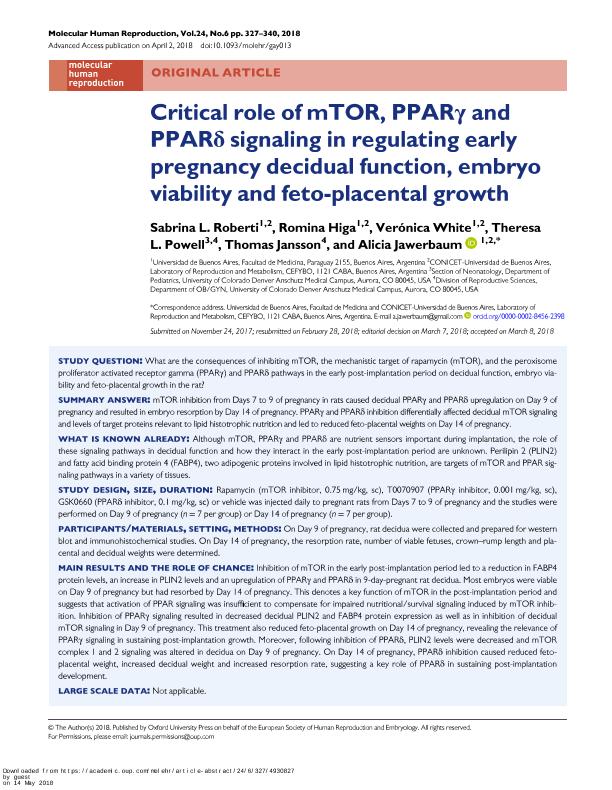Mostrar el registro sencillo del ítem
dc.contributor.author
Roberti, Sabrina Lorena

dc.contributor.author
Higa, Romina Daniela

dc.contributor.author
White, Verónica

dc.contributor.author
Powell, Theresa L.
dc.contributor.author
Jansson, Thomas
dc.contributor.author
Jawerbaum, Alicia Sandra

dc.date.available
2019-10-24T20:59:26Z
dc.date.issued
2018-06
dc.identifier.citation
Roberti, Sabrina Lorena; Higa, Romina Daniela; White, Verónica; Powell, Theresa L.; Jansson, Thomas; et al.; Critical role of mTOR, PPARγ and PPARδ signaling in regulating early pregnancy decidual function, embryo viability and feto-placental growth; Oxford University Press; Molecular Human Reproduction; 24; 6; 6-2018; 327-340
dc.identifier.issn
1360-9947
dc.identifier.uri
http://hdl.handle.net/11336/87275
dc.description.abstract
STUDY QUESTION: What are the consequences of inhibiting mTOR, the mechanistic target of rapamycin (mTOR), and the peroxisome proliferator activated receptor gamma (PPARγ) and PPARδ pathways in the early post-implantation period on decidual function, embryo viability and feto-placental growth in the ratγ SUMMARY ANSWER: mTOR inhibition from Days 7 to 9 of pregnancy in rats caused decidual PPARγ and PPARδ upregulation on Day 9 of pregnancy and resulted in embryo resorption by Day 14 of pregnancy. PPARγ and PPARδ inhibition differentially affected decidual mTOR signaling and levels of target proteins relevant to lipid histotrophic nutrition and led to reduced feto-placental weights on Day 14 of pregnancy.
WHAT IS KNOWN ALREADY: Although mTOR, PPARγ and PPARδ are nutrient sensors important during implantation, the role of these signaling pathways in decidual function and how they interact in the early post-implantation period are unknown. Perilipin 2 (PLIN2) and fatty acid binding protein 4 (FABP4), two adipogenic proteins involved in lipid histotrophic nutrition, are targets of mTOR and PPAR signaling pathways in a variety of tissues. STUDY DESIGN, SIZE, DURATION: Rapamycin (mTOR inhibitor, 0.75 mg/kg, sc), T0070907 (PPARγ inhibitor, 0.001 mg/kg, sc), GSK0660 (PPARδ inhibitor, 0.1 mg/kg, sc) or vehicle was injected daily to pregnant rats from Days 7 to 9 of pregnancy and the studies were performed on Day 9 of pregnancy (n = 7 per group) or Day 14 of pregnancy (n = 7 per group).
PARTICIPANTS/MATERIALS, SETTING, METHODS: On Day 9 of pregnancy, rat decidua were collected and prepared for western blot and immunohistochemical studies. On Day 14 of pregnancy, the resorption rate, number of viable fetuses, crown-rump length and placental and decidual weights were determined.
MAIN RESULTS AND THE ROLE OF CHANCE: Inhibition of mTOR in the early post-implantation period led to a reduction in FABP4 protein levels, an increase in PLIN2 levels and an upregulation of PPARγ and PPARδ in 9-day-pregnant rat decidua. Most embryos were viable on Day 9 of pregnancy but had resorbed by Day 14 of pregnancy. This denotes a key function of mTOR in the post-implantation period and suggests that activation of PPAR signaling was insufficient to compensate for impaired nutritional/survival signaling induced by mTOR inhibition. Inhibition of PPARγ signaling resulted in decreased decidual PLIN2 and FABP4 protein expression as well as in inhibition of decidual mTOR signaling in Day 9 of pregnancy. This treatment also reduced feto-placental growth on Day 14 of pregnancy, revealing the relevance of PPARγ signaling in sustaining post-implantation growth. Moreover, following inhibition of PPARδ, PLIN2 levels were decreased and mTOR complex 1 and 2 signaling was altered in decidua on Day 9 of pregnancy. On Day 14 of pregnancy, PPARδ inhibition caused reduced fetoplacental weight, increased decidual weight and increased resorption rate, suggesting a key role of PPARδ in sustaining post-implantation development.
LARGE SCALE DATA: Not applicable.
LIMITATIONS, REASONS FOR CAUTION: This is an in vivo animal study and the relevance of the results for humans remains to be established.
WIDER IMPLICATIONS OF THE FINDINGS: The early post-implantation period is a critical window of development and changes in the intrauterine environment may cause embryo resorption and lead to placental and fetal growth restriction. mTOR, PPARγ and PPARδ signaling are decidual nutrient sensors with extensive cross-talk that regulates adipogenic proteins involved in histotrophic nutrition and important for embryo viability and early placental and fetal development and growth. STUDY FUNDING/COMPETING INTEREST(S): Funding was provided by the Agencia Nacional de Promoción Científica y Tecnológica de Argentina (PICT 2014-411 and PICT 2015-0130), and by the International Cooperation (Grants CONICET-NIH-2014 and CONICETNIH- 2017) to A.J. and T.J. The authors have no conflicts of interest.
dc.format
application/pdf
dc.language.iso
eng
dc.publisher
Oxford University Press

dc.rights
info:eu-repo/semantics/openAccess
dc.rights
Atribución-NoComercial-CompartirIgual 2.5 Argentina (CC BY-NC-SA 2.5 AR)
dc.rights.uri
https://creativecommons.org/licenses/by-nc-sa/2.5/ar/
dc.subject
DECIDUA
dc.subject
EMBRYO RESORPTION
dc.subject
HISTOTROPHIC NUTRITION
dc.subject
PPARS
dc.subject
MTOR
dc.subject.classification
Biología del Desarrollo

dc.subject.classification
Ciencias Biológicas

dc.subject.classification
CIENCIAS NATURALES Y EXACTAS

dc.title
Critical role of mTOR, PPARγ and PPARδ signaling in regulating early pregnancy decidual function, embryo viability and feto-placental growth
dc.type
info:eu-repo/semantics/article
dc.type
info:ar-repo/semantics/artículo
dc.type
info:eu-repo/semantics/publishedVersion
dc.date.updated
2019-10-22T14:58:50Z
dc.journal.volume
24
dc.journal.number
6
dc.journal.pagination
327-340
dc.journal.pais
Reino Unido

dc.journal.ciudad
Oxford
dc.description.fil
Fil: Roberti, Sabrina Lorena. Consejo Nacional de Investigaciones Científicas y Técnicas. Oficina de Coordinación Administrativa Houssay. Centro de Estudios Farmacológicos y Botánicos. Universidad de Buenos Aires. Facultad de Medicina. Centro de Estudios Farmacológicos y Botánicos; Argentina
dc.description.fil
Fil: Higa, Romina Daniela. Consejo Nacional de Investigaciones Científicas y Técnicas. Oficina de Coordinación Administrativa Houssay. Centro de Estudios Farmacológicos y Botánicos. Universidad de Buenos Aires. Facultad de Medicina. Centro de Estudios Farmacológicos y Botánicos; Argentina
dc.description.fil
Fil: White, Verónica. Consejo Nacional de Investigaciones Científicas y Técnicas. Oficina de Coordinación Administrativa Houssay. Centro de Estudios Farmacológicos y Botánicos. Universidad de Buenos Aires. Facultad de Medicina. Centro de Estudios Farmacológicos y Botánicos; Argentina
dc.description.fil
Fil: Powell, Theresa L.. State University of Colorado at Boulder; Estados Unidos
dc.description.fil
Fil: Jansson, Thomas. State University of Colorado at Boulder; Estados Unidos
dc.description.fil
Fil: Jawerbaum, Alicia Sandra. Consejo Nacional de Investigaciones Científicas y Técnicas. Oficina de Coordinación Administrativa Houssay. Centro de Estudios Farmacológicos y Botánicos. Universidad de Buenos Aires. Facultad de Medicina. Centro de Estudios Farmacológicos y Botánicos; Argentina
dc.journal.title
Molecular Human Reproduction

dc.relation.alternativeid
info:eu-repo/semantics/altIdentifier/url/https://www.ncbi.nlm.nih.gov/pmc/articles/PMC6676979/
dc.relation.alternativeid
info:eu-repo/semantics/altIdentifier/url/https://academic.oup.com/molehr/article/24/6/327/4930827
Archivos asociados
